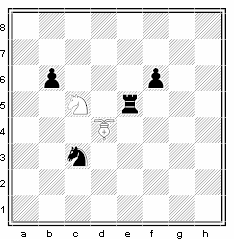Palace Ninja Guards
This game was accidentally invented while the author was conceiving an upcoming large board chess variant. Subsequent testing has proved this to be quite a playable game.
The new pair of pieces: the ninja guards are very similar to some versions of pieces such as the Elephant or Alfil.
Two squares on the center of each side's backrank make up the palace and add a new strategic concept of being able to leave the king in the center quite safely. (Castling is permitted just as in orthodox chess).
Setup
 |
Start Position for white (black mirrors this)
Rooks on a1, h1 Knights on b1 and g1 Bishops on c1 and f1 Queen on d1 King on e1 Ninja Guards on d0 and e0 |
Pieces
The only new piece to the original orthodox chessmen is the ninja guard.The Ninja Guard’s Moves
The Ninja Guard is a color bound piece that can move one or two steps diagonally. It can leap over a diagonally adjacent friendly piece to land exactly 2 squares away (a two-space diagonal leap). It can capture on any square it lands, and additionally it can can capture an enemy piece that is diagonally adjacent by jumping over it. It can capture two pieces that stand immediately adjacent in its path on a diagonal (the first diagonally adjacent to it, and the next, right after) by jumping over the first one and capturing the second piece on the square it lands.
|
The Ninja Guard on d4 can capture all the pieces in the diagram.
It can capture the pawn on b6 by jumping over the knight at c5. It can capture the knight on c3 by moving to c3 or by jumping over the knight and landing on b2. It can capture the rook on e5 by moving to e5 or it can capture both the rook and the pawn by jumping over to f6. |
Rules
The rules in this game are identical to chess, except that pawns can now promote to Ninja Guards if desired.
Optional Rule - Capture the Scepter
If desired, the game can be played with the following rule:
In addition to the usual way of winning by checkmate,
any side can also win by moving its king to the opponent's rear side of the
palace (the squares: d9, e9 for white or d0, e0 for black) without being captured i.e. if the squares are not protected by the
opponent's pieces. The reason is that there is a scepter located at the rear of the palace (on any of the two protruding squares)
and if retrieved by the opposing king results in an immediate loss!
So the endgame now will involve additional strategy in trying to prevent your opponent from capturing your scepter while
trying to capture your opponent's scepter.
Since the usual rules of stalemate and 3-move repetition apply, the use of the opposition is key here.
Notes
The two squares in the middle can be used as a safety area for the king in certain cases, and instead of castling, the king can be tucked in the rear of the palace. This might be useful when the center is blocked and the opponent has already castled, making a wing attack very feasible.
The relative values of the ninja guards are quite close to the bishop or the knight. On an open board, the bishop has more mobility, but on a more crowded board, the ninja guards are as powerful as a knight.
 This 'user submitted' page is a collaboration between the posting user and the Chess Variant Pages. Registered contributors to the Chess Variant Pages have the ability to post their own works, subject to review and editing by the Chess Variant Pages Editorial Staff.
This 'user submitted' page is a collaboration between the posting user and the Chess Variant Pages. Registered contributors to the Chess Variant Pages have the ability to post their own works, subject to review and editing by the Chess Variant Pages Editorial Staff.
By Charles Daniel.
Last revised by Greg Strong.
Web page created: 2007-09-27. Web page last updated: 2020-09-24
